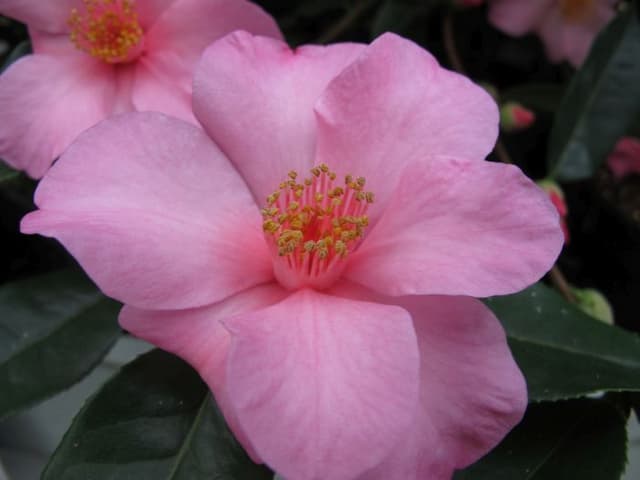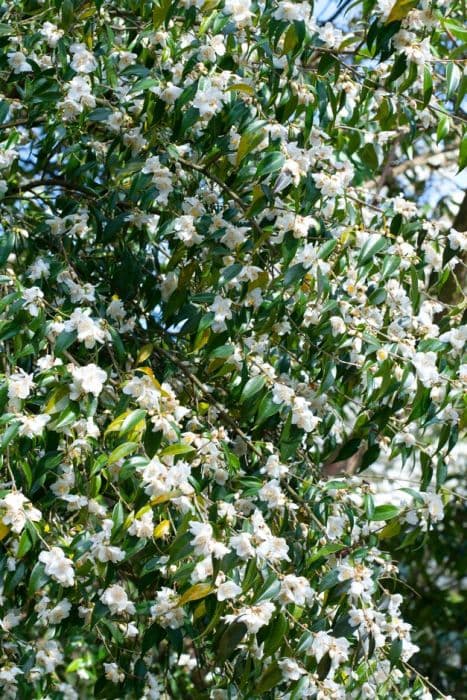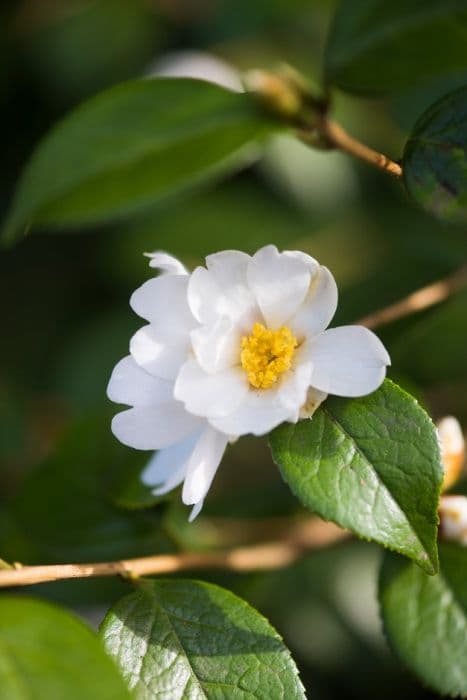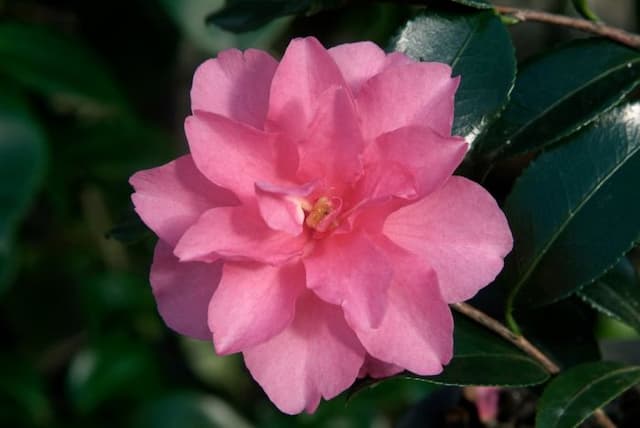Japanese Camellia Camellia japonica 'Nuccio's Gem'

ABOUT
The Camellia japonica 'Nuccio's Gem' is recognized for its lush, glossy green leaves which provide a rich backdrop to its stunning blossoms. This evergreen shrub bears exquisite flowers that have a formal, perfect symmetry. The blooms are a radiant white, with a velvety texture that can almost appear to be porcelain. Each flower is composed of numerous neatly arranged petals that overlap and create a dense, peony-like form. The blossoms make a striking contrast against the dark foliage and can be quite eye-catching when the plant is in full bloom. This variety is a favorite among gardeners who appreciate its elegant and pristine appearance, as well as its ability to add a touch of sophisticated beauty to any landscape.
About this plant
 Names
NamesFamily
Theaceae.
Synonyms
Japanese Camellia, Japonica, Camellia.
Common names
Camellia japonica 'Nuccio's Gem'.
 Toxicity
ToxicityTo humans
Japanese camellia, which is the common name for Camellia japonica 'Nuccio's Gem', is not considered toxic to humans. Generally, there is no significant danger associated with ingesting parts of this plant, and it is not known to cause poisoning. Therefore, there are no specific symptoms of poisoning related to the Japanese camellia.
To pets
Japanese camellia is also not considered toxic to pets. This includes both cats and dogs. Ingesting parts of the Japanese camellia plant should not lead to poisoning, and there should not be any adverse effects or specific symptoms associated with the plant's ingestion by pets.
 Characteristics
CharacteristicsLife cycle
Perennials
Foliage type
Evergreen
Color of leaves
Dark green
Flower color
White
Height
6-10 feet (1.8-3.0 meters)
Spread
5-7 feet (1.5-2.1 meters)
Plant type
Shrub
Hardiness zones
7-9
Native area
Japan
Benefits
 General Benefits
General Benefits- Ornamental Value: The Camellia japonica 'Nuccio's Gem', commonly known as camellia, boasts stunning white, formal double flowers that enhance the visual appeal of gardens and landscapes.
- Year-Round Interest: Camellias provide evergreen foliage offering greenery throughout the year, with flowering typically occurring in late winter to early spring, adding color when many other plants are dormant.
- Diverse Landscaping Uses: Camellias can serve various landscaping roles, including being used as specimen plants, privacy screens, or as part of hedging and foundation plantings.
- Shade Tolerance: Camellias can thrive in partial shade, making them suitable for shaded areas where other flowering plants might not perform well.
- Low Maintenance: Once established, camellias require minimal care, needing only occasional pruning and watering during dry spells.
- Drought Resistance: Mature camellias have some degree of drought tolerance, although they prefer regular watering.
- Long Lifespan: Camellias are long-lived plants, capable of bringing enjoyment for decades when given proper care.
- Resistance to Pests: They are relatively resistant to pests, reducing the need for chemical treatments.
 Medical Properties
Medical PropertiesThis plant is not used for medical purposes.
 Air-purifying Qualities
Air-purifying QualitiesThis plant is not specifically known for air purifying qualities.
 Other Uses
Other Uses- Camellia japonica 'Nuccio's Gem' leaves are sometimes used in the craft of marbling paper, where their waxy substance creates unique patterns and textures on paper surfaces.
- The petals of Camellia japonica 'Nuccio's Gem' can be used to make a natural dye for fabric, producing shades of pink or red depending on the mordant used.
- Flower artists can utilize the camellia's durable petals in creating floral arrangements, corsages, and boutonnieres due to their long-lasting nature after being cut.
- The sturdy, glossy leaves of the camellia can be used as a natural substitute for plastic or cellophane when wrapping small gifts or as part of a biodegradable presentation.
- When dried and pressed, Camellia japonica 'Nuccio's Gem' flowers are used in scrapbooking and card making for their beauty and rich color.
- In Japan, the camellia is used in the art of Tsubaki-tsuki, where blooms and leaves decorate traditional candles used in ceremonies and special occasions.
- Working as an artistic subject, Camellia japonica 'Nuccio's Gem' is often featured in botanical illustration and photography because of its symmetrical flowers and vibrant color.
- Camellia japonica 'Nuccio's Gem' petals can be incorporated into handmade papers, adding texture and flecks of color to the finished product.
- Used in culinary presentations, the non-toxic petals of Camellia japonica 'Nuccio's Gem' can ornately accent desserts and plating, though the petals themselves are not eaten.
- The wood of the camellia is sometimes carved into small ornamental items or used in intarsia woodworking for its smooth grain and stability.
Interesting Facts
 Feng Shui
Feng ShuiCamellia is associated with positive Feng Shui energy, symbolizing love, affection, and admiration. It can be used in the southwest sector of a garden or home to enhance the romance and relationship area, or placed in the east for health and family growth. Its blooms may also bring good fortune when placed in areas of the home signifying prosperity.
 Zodiac Sign Compitability
Zodiac Sign CompitabilityThe Camellia is not used in astrology practice.
 Plant Symbolism
Plant Symbolism- Love: The Camellia flower is often associated with deep desire, passion, and romantic love. 'Nuccio's Gem', with its delicate, perfect petals and rich color, could symbolize an unblemished and enduring love.
- Admiration: Camellias carry the meaning of admiration and perfection. Presenting someone with a 'Nuccio's Gem' Camellia could suggest that they are seen as perfect in the eyes of the giver.
- Devotion: Due to the lasting nature of Camellia blooms, they are often symbolic of long-term devotion and commitment. They could represent the steadfast nature of a relationship.
- Beauty: The exquisite form and beauty of the 'Nuccio's Gem' Camellia make it a symbol of beauty in many cultures, implying the inner and outer beauty of the person receiving the flower.
- Affection: With its soft, dense petals, the Camellia is also a symbol of affection and warm feelings, indicating a deep fondness or platonic love.
 Water
WaterThe Camellia, commonly known as the Japanese camellia, requires consistent moisture and should be watered when the top inch of soil feels dry to the touch. Water the plant deeply, using about 1 gallon of water for small to medium-sized shrubs, increasing to 2-3 gallons for larger plants, about once a week during the growing season. In hotter, drier periods, you may need to water twice a week, while in cooler or rainy seasons, reduce the watering frequency. Ensure water is applied at the base of the plant to avoid wetting the foliage, which can promote disease. Always avoid overwatering as this can lead to root rot, which can be detrimental to the Camellia.
 Light
LightThe Japanese camellia thrives in partial shade, with dappled sunlight being ideal. It should be protected from the hot afternoon sun, so a spot that receives morning light and afternoon shade would be best. Avoid deep shade as it can lead to fewer blooms and leggy growth.
 Temperature
TemperatureThe Japanese camellia prefers moderate temperatures and can generally tolerate minimum temperatures down to around 10 degrees Fahrenheit, but ideally should not be exposed to temperatures below freezing for best growth. The ideal temperature range for Camellias is between 50 and 70 degrees Fahrenheit, with protection from harsh winter winds being crucial. Avoid areas where temperatures drop below the threshold for extended periods to prevent damage to the plant.
 Pruning
PruningPrune your Japanese camellia to maintain shape and encourage bushier growth, as well as to remove any dead or diseased wood. The best time to prune is just after the blooms have faded in the spring, as Camellias set their flower buds in summer for the following season. Pruning too late can result in removing next year's blooms. It's recommended to prune lightly each year rather than severely pruning every few years.
 Cleaning
CleaningAs needed
 Soil
SoilThe best soil mix for a Camellia, commonly called Japanese camellia, is well-draining, rich in organic matter, and slightly acidic with a pH of 5.5 to 6.5. A mix consisting of equal parts potting soil, peat moss, and pine bark would be ideal. Ensure the soil allows for proper aeration and moisture retention to support healthy root growth.
 Repotting
RepottingJapanese camellias should be repotted every 2 to 3 years or when the plant becomes root-bound. Younger camellias might need repotting more frequently, whereas mature plants can be repotted less often. Choose a container only slightly larger than the current one to prevent overwatering.
 Humidity & Misting
Humidity & MistingJapanese camellias thrive best in moderate to high humidity levels, with ideal humidity ranging from 50% to 80%. These plants benefit from a moist environment, which can be achieved by placing a humidifier nearby or using a pebble tray filled with water under the pot.
 Suitable locations
Suitable locationsIndoor
Position near bright, indirect light and maintain high humidity.
Outdoor
Partial shade, sheltered from intense afternoon sun and wind.
Hardiness zone
7-9 USDA
 Life cycle
Life cycleCamellia japonica 'Nuccio's Gem', commonly known as Nuccio's Gem Camellia, begins its life as a seed, which upon germination grows into a seedling with the characteristic glossy green leaves. The seedling stage transitions into a juvenile vegetative phase, where the plant focuses its energy on root and foliage development, establishing a sturdy framework for future growth. As the plant matures, it enters the adult vegetative stage, continuing to expand in size and form, and starts to develop flower buds. Flowering occurs typically in late winter to early spring; Nuccio's Gem Camellia produces large, formal double white blooms that are admired for their beauty. After pollination, which is often facilitated by insects, the flowers will develop into fruit, consisting of dry capsules containing seeds that can disperse to begin new life cycles. Throughout its life, the plant may also propagate asexually through cuttings, enabling the cultivation of genetically identical offspring.
 Propogation
PropogationPropogation time
Spring-Early Summer
Propogation: Camellia japonica 'Nuccio's Gem', commonly known as the Japanese camellia, is typically propagated through semi-hardwood cuttings. The best time for this method is in late summer when the plant has new growth that has begun to mature but is not fully hardened. To propagate, a cutting of about 4 to 6 inches (approximately 10 to 15 centimeters) is taken from a healthy plant. This cutting should have several leaves and be from a part of the branch that is not flower-bearing. The lower leaves are removed, and the cut end is dipped in rooting hormone before being placed in a well-draining potting mix. The cutting should be kept moist and in a warm environment with indirect sunlight until roots develop, typically within 6 to 8 weeks. During this period, a plastic cover or dome can be used to maintain humidity around the cutting, enhancing root development.









